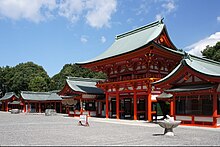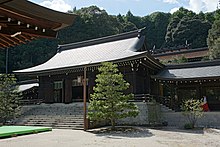Ōmi-jingū
The Ōmi-jingū ( Japanese. 近 江 神宮 ) is a Shintō shrine in the Japanese city of Ōtsu ( Shiga Prefecture ). It was founded in 1940 (on the occasion of the 2600th anniversary of the founding of the empire by the legendary Jimmu - tennō ) and belongs to the Chokusaisha .
The top kami of the Ōmi-jingū is the Tenji- tennō, who moved the capital of Japan from Asuka-kyō (today: Asuka ) to Ōmi-kyō (today: heutetsu) in 667 .
The shrine's annual festival ( 例 祭 , Reisai ) takes place on April 20th. On June 10th, the time commemoration day ( 時 enn 記念 日 , Toki-no-kinembi ) commemorates the invention of the water clock by Tenji-tennō.
On the 20 hectare grounds of the shrine there is also a clock museum , in which, in addition to around 3,000 other exhibits, there is a model of a water clock made by Tenji-tennō, supposedly the oldest clock in Japan.
Web links
- Official Website - Japanese
- Photo gallery - Japanese
Coordinates: 35 ° 1 '56.4 " N , 135 ° 51' 5.49" E

